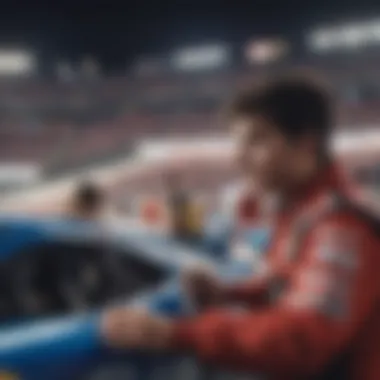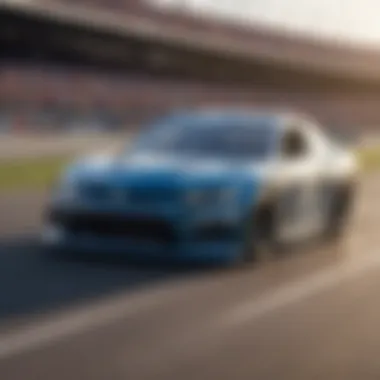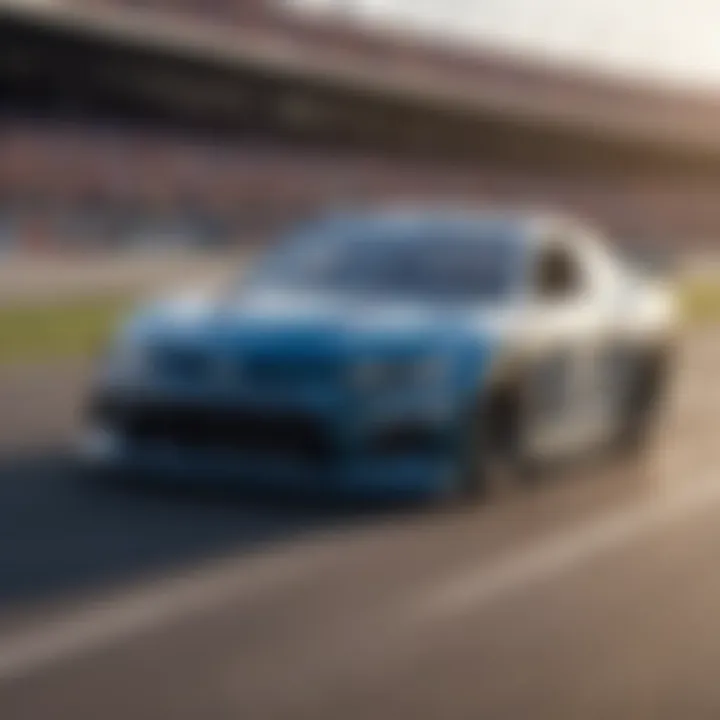Exploring the iHeartRadio and NASCAR Collaborative Impact


Intro
The partnership between iHeartRadio and NASCAR represents a fusion of two seemingly distinct worlds—broadcasting and auto racing. However, a deeper look unveils a relationship that not only elevates media consumption but also deeply intertwines with the racing community and its fans. This collaboration came to life against a backdrop of evolving consumer preferences and the rise of digital platforms, all while aiming to strengthen brand engagement within the automotive industry.
Through comprehensive exploration, we’ll delve into how their alliance has transformed the landscape of racing media, the implications for advertising within and beyond the sport, and the way it affects audience engagement. Motorsport traditionally relies on television and radio broadcasting, but with the technological advancements spurred by iHeartRadio, NASCAR now has a significant opportunity to reach fans far beyond the track.
We'll uncover these dimensions by examining the history of their collaboration, the technological innovations in broadcasting, pivotal changes in fan engagement strategies, and the way this partnership sets the stage for future developments. By weaving together insights on industry trends and fan dynamics, this article paints a vivid picture of how iHeartRadio and NASCAR have created a synergistic relationship that enhances the experience for everyone involved—from die-hard racing enthusiasts to casual listeners tuning in for the thrill of the chase.
Let’s kick off our detailed journey into the world where the roar of engines meets the rhythm of radio.
Preface to iHeartRadio and NASCAR
The partnership between iHeartRadio and NASCAR is not just a blending of two brands; it’s a hallmark of how media and entertainment can evolve to meet the expectations of a new generation of consumers. This collaboration addresses the cultural fabric of automotive racing while enhancing the listening experience for fans. The exploration of this relationship offers insights into the mechanics of modern media consumption and the significance of strategic partnerships in the entertainment landscape.
Understanding iHeartRadio
Initially hitting the airwaves in 2008, iHeartRadio has transformed the way people engage with music and talk radio. It’s not your run-of-the-mill radio station; it’s an entire ecosystem of content that connects listeners with their favorite tunes, podcasts, and live events. With over 850 radio stations, iHeartRadio has gained immense reach, appealing particularly to younger demographics.
A standout feature of iHeartRadio is its adaptability. Users can browse their choices by genre, discover emerging artists, and even create custom playlists. This dynamic platform is a prime example of how digital media can cater to diverse preferences, allowing for greater consumer engagement.
The nuance of the relationship with NASCAR comes through in how iHeartRadio delivers live race coverage, driver interviews, and insights into the NASCAR world directly to fans. Through this partnership, iHeartRadio doesn’t just provide sound waves; it cultivates an experience that resonates on a deeper level with its audience.
Overview of NASCAR
NASCAR, as an integral part of American sports culture, isn’t simply a racing organization; it’s a phenomenon rich in history and passion. Founded in 1948, this motorsport has transcended its origins, captivating millions with thrilling races and charismatic drivers. What sets NASCAR apart is its ability to build a community around engines, tires, and the roar of racing. Fans don’t merely watch races; they experience them.
More than just cars speeding around an oval track, NASCAR embodies strategy, teamwork, and loyalty. The series encompasses multiple races throughout the year, including the iconic Daytona 500, which draws massive audiences both in-person and via broadcasts.
One crucial aspect of NASCAR's allure has been its evolving relationship with technology and media. As the sport adapts to changes in how audiences consume content, it becomes clear that partnerships, like the one with iHeartRadio, are pivotal in bringing this exhilarating experience into the hands of devoted fans.
"In terms of motorsports, NASCAR isn't just about the cars; it’s about the culture. It’s about the energy each event generates, giving fans a sense of belonging."
Historical Context: The Partnership Emerges
The relationship between iHeartRadio and NASCAR is an intricate tapestry woven over time, highlighting the evolution of both entities. Understanding this historical context provides critical insights into how their partnership blossomed and what it signifies for the media and racing industries today. At the heart of this alliance lies a mutual goal—to engage fans in innovative ways while amplifying their respective brands.
From the outset, the partnership was characterized by initial collaborations that laid the groundwork for future synergies. iHeartRadio's commitment to diversifying its content through live events and unique programming dovetailed seamlessly with NASCAR’s desire to reach broader audiences beyond the traditional viewership. It’s not just about listeners; it’s about cultivating a community of passionate racing enthusiasts eager for connection.
Initial Collaborations
The dawn of this partnership can be traced back to several key collaborations that came together like pieces of a jigsaw puzzle. Initially, iHeartRadio began airing NASCAR-related content, including pre-race shows and highlights, which served to introduce the excitement of the races to a broader audience. These early moves were pivotal in integrating NASCAR's thrilling events into the daily lives of fans who might not tune in to traditional broadcasts.
Another significant aspect was the use of iHeartRadio’s extensive reach through various radio channels, allowing NASCAR to tap into demographic segments previously untapped. Listener engagement skyrocketed as racing enthusiasts found themselves getting daily doses of their favorite sport via music and talk radio alike. It also opened the doors for joint promotional events, effectively merging the realms of radio entertainment and high-speed thrills.
Expanding the Relationship
As the years rolled on, the contours of this partnership began to expand, illustrating the adaptive nature of both organizations. New avenues of collaboration emerged, pushing the limits of creativity and technological advancements. For instance, special events that featured interviews with NASCAR drivers began to form a central part of iHeartRadio's programming strategy.
Moreover, as digital platforms grew dominant, the partnership evolved to incorporate podcasting—a medium that’s taken the world by storm. NASCAR-themed podcasts found a natural home on iHeartRadio, offering comprehensive race analyses, driver insights, and fan interactions. This shift was not merely a response to changing consumption patterns but a strategic move that reinforced both brands' positions as leaders in their fields.
"The partnership between iHeartRadio and NASCAR reflects a significant transformation in media consumption, showcasing how collaboration can enhance audience experience beyond traditional methods."
Furthermore, with technological enhancements in streaming services, the partnership began to leverage analytics and data, crafting targeted content that resonated with specific fan segments. This analytical approach not only improved audience engagement but also equipped sponsors with invaluable insights into their investments.
Broadcasting Innovations in NASCAR
The world of NASCAR broadcasting has undergone a seismic transformation in recent years, driven largely by technological advances and a shift towards digital platforms. These innovations are critical not just for how races are presented, but also for the entire fan experience and media consumption landscape within the racing community. The blending of traditional broadcasting with cutting-edge digital media has created a multi-faceted approach that engages a wider array of viewers and listeners.
The Shift to Digital Media
As the saying goes, "out with the old and in with the new." This adage could not be truer in the context of NASCAR’s league-wide embrace of digital media. For decades, fans relied on television broadcasts to keep up with races, but now, they can access race-related content anywhere, anytime.


- Accessibility is a significant factor here. Fans need not rely solely on cable subscriptions; they can connect through various streaming services. This accessibility has paved the way for more individuals to become fans, expanding NASCAR’s reach.
- Fan interaction has also seen notable improvements. Through platforms like iHeartRadio, fans can access live radio coverage, exclusive commentary, and behind-the-scenes insights. This direct engagement with reporters and analysts offers something traditional broadcasts often lack—a more intimate connection.
Additionally, this transition signifies a major cultural shift. Younger generations, who prioritize on-demand access over clock-watching, find NASCAR's embrace of digital media right in tune with their preferences. It means that a past-time, once experienced through standard broadcasts, has now become a dynamic, interactive activity, all at the fingertips of the fans.
Role of Podcasts and Streaming
Podcasts and streaming services have emerged as central pillars in NASCAR's broadcasting strategy. These platforms permit an unprecedented level of flexibility for fans, allowing them to consume content on their own terms.
- Podcasts offer deep dives into races, driver interviews, and expert discussions that expand beyond the 5-minute recaps or pre-show chatter of traditional broadcasts. They cater to those passionate about the intricate stories behind the sport, such as a driver’s journey or the technical details of vehicle performance.
- Streaming services allow for live race coverage as well as replays, making it simple for fans to catch critical moments they might have missed. According to data, these platforms have contributed to an increase in audience engagement metrics, illustrating their significance in modern viewing habits.
"In a world driven by instant gratification, the ability to stream races and catch up with entertaining podcasts extends NASCAR's appeal well beyond the traditional fan base."
All in all, the broadcast innovations in NASCAR have transformed not just how races are viewed, but also how fans engage with the sport on a regular basis. The synergy between iHeartRadio and NASCAR exemplifies how these enhancements can amplify the experience, capturing passionate fans and potentially pulling in those who’ve never been interested before. As technology continues to develop, so too will NASCAR’s adaptability in the world of broadcasting, ensuring that the sport remains relevant in an increasingly digital age.
Audience Engagement Strategies
In today’s media landscape, engaging audiences is not just a nice-to-have; it’s a key asset for organizations like iHeartRadio and NASCAR. A solid audience engagement strategy helps maintain a loyal fan base, attract new listeners and viewers, and deepen the overall connection to the sport. Given NASCAR’s unique position as a sport that blends speed with connecting stories, the collaboration with iHeartRadio is instrumental in elevating these elements.
Targeting NASCAR Fans
Understanding the audience is vital, and for NASCAR, the fan demographic is as unique as the cars on the track. iHeartRadio has recognized that racing fans not only thirst for updates on their favorite drivers but also enjoy behind-the-scenes narratives and live commentary. This isn’t just about announcing laps; this is storytelling that resonates.
Moreover, an effective tactic is segmenting the audience based on their interests. For instance:
- Die-hard fans may appreciate technical analyses, driver interviews, or historical race recaps.
- Casual viewers might prefer highlights, quick updates, and entertainment-focused content.
Tailoring programming helps in captivating various segments of the audience. By utilizing listener data from iHeartRadio, NASCAR can discern trends and preferences, allowing for personalized content delivery. This can involve everything from choosing the right time slots for broadcasts to deciding what type of content to emphasize. A focused approach not only boosts engagement but fosters a sense of community.
Leveraging Social Media Platforms
The role of social media in the modern entertainment sphere cannot be overstated. Platforms such as Twitter, Facebook, and Instagram have become essential outlets for reaching audiences. iHeartRadio has adeptly utilized these channels to circulate NASCAR-related content, promote events, and facilitate discussions.
NASCAR can draw fans into conversations on social platforms—whether it’s through polls on upcoming races, sharing live snippets from events, or user-generated content showcasing fans' experiences. Engaging with followers and encouraging them to post about their excitement can morph passive viewers into active participants.
- Creating event hashtags: This generates buzz and encourages fans to join discussions.
- Host live Q&A sessions: This deepens connection with audiences, making them feel valued and heard.
- Incorporate multimedia: Pictures, videos, or podcasts can appeal to diverse preferences.
Engagement isn’t merely about being present; it’s about creating a tangible connection. Social media provides a direct line from NASCAR to its fans, fostering stronger ties and a community atmosphere that keeps enthusiasm high.
"Involving fans in discussions and activities outside the race track is fundamental to broadening the audience and enhancing loyalty to the brand."
In summary, audience engagement strategies through targeted content and social media leverage are compelling methods enabling iHeartRadio and NASCAR to connect, entertain, and retain fans. By focusing on these essential tactics, both entities continue to innovate and excite, keeping the fans on their toes as they cheer for their favorites.
Advertising and Sponsorship Impact
The partnership between iHeartRadio and NASCAR brings significant advantages to both entities, particularly in the realms of advertising and sponsorship. This collaboration not only enhances fan engagement but also opens up new avenues for brands looking to reach a specific, passionate audience. It’s essential to recognize how this synergy affects marketing strategies and the effectiveness of sponsorship deals within the fast-paced environment of motorsports.
Shifts in Advertising Strategies
In recent years, the advertising landscape has seen remarkable transformations. Traditional advertising methods, while still prevalent, have taken a back seat to more modern digital approaches. With the rise of streaming services like iHeartRadio, advertisers are keen to adapt. The evolution towards digital has meant targeting audiences through tailored content delivery rather than broad-spectrum campaigns.
NASCAR, long a bastion of traditional advertising, is increasingly seeing brands shift their focus. Here’s a glance at notable trends:
- Data-Driven Decisions: Advertisers now rely heavily on data analytics to formulate strategies. By examining listener habits on iHeartRadio, brands can uncover insights that help them tailor their messages effectively.
- Personalized Engagement: Engaging fans through personalized ads enhances the likelihood of connection. By blending sponsorship with customized entertainment via podcasts or live broadcasts, brands create deeper relationships with consumers.
- Dynamic Content Creation: Collaborations enable the development of unique content that resonates with fans. For instance, integrating brand messaging within race commentary or promotional segments during broadcasts allows for a seamless advertisement experience.
These strategies are not merely passing trends; they signal a fundamental reshaping of how advertisers interact with fans and consumers.
Measuring ROI for Sponsors
Evaluating the success of advertising strategies can be challenging, especially in a continuously evolving landscape like motorsports. The effectiveness of sponsorship deals can often be gauged through key performance indicators (KPIs). Here’s a breakdown of how to measure return on investment (ROI) for sponsors in this collaborative environment:
- Brand Awareness: One of the primary goals of sponsorship is to increase visibility. Metrics such as social media mentions, website traffic, and overall brand reach during race events can provide insight into awareness levels.
- Engagement Rates: Tracking listener engagement on platforms like iHeartRadio is crucial. High listener interaction, including shares, likes, and comments, often signifies a successful campaign.
- Sales Conversions: Ultimately, sales figures resulting from advertising efforts should always be monitored. Utilizing promo codes or special offers tied to race events can offer concrete data on how effectively a sponsorship translates to sales.
- Audience Surveys: Conducting surveys following major races can shed light on audience perception of brands. This feedback helps gauge how well sponsorships resonate and their effectiveness in building brand loyalty.
"The marriage of tradition and modernity in NASCAR-Z iHeartRadio partnerships creates a powerful advertising ecosystem, reflecting both brands' commitment to innovative engagement and consumer insights."


Overall, it becomes clear that the partnership not only paves the way for robust advertising but also demands a sophisticated approach to measure its impact. The ongoing evolution in advertising strategies illustrates a broader trend towards data utilization and personalized engagement in the automotive entertainment space.
Technological Advances in Racing Broadcasts
Technological advances in racing broadcasts have fundamentally transformed how fans engage with NASCAR events. The immersion offered by these innovations sets the stage for a richer, more dynamic viewing experience, allowing fans to feel as though they are part of the action. This is not just about watching races; it's about creating connections and nurturing a sense of community among fans. With NASCAR's gritty thrills and high speeds, the adoption of cutting-edge technology ensures that viewers don’t just spectate but engage deeply with the sport.
Enhanced Viewing Experiences
The way fans consume racing content has radically changed over the years. Now, technology like augmented reality (AR) and virtual reality (VR) serves as the new frontier for race broadcasting. These technologies elevate the viewing experience beyond traditional screens. Imagine slipping on a headset and being placed right behind the wheel during a high-stakes race; that's what AR and VR bring to the table. With features like 360-degree views of the race, fans can choose their angle, immersing themselves in the heart of the action—whether it’s in the driver’s seat or on the pit road.
Additionally, iHeartRadio’s integration of live audio broadcasts with real-time data can significantly enhance enjoyment. Think of it: listening to a live radio call while following along with a live leaderboard. This fusion of audio and visual content creates a holistic experience. It’s not just sound; it’s the symphony of engines roaring combined with the pulse of competition playing out in real-time.
In essence, these enhanced experiences do not just cater to existing fans; they help attract new audiences who thrive on innovation and interactivity. To put it another way, technology pushes the boundaries of what racing fans can expect from each event.
Utilizing Data for Fan Engagement
In this fast-paced digital age, data isn't just useful; it's essential. NASCAR and iHeartRadio leverage vast amounts of data to tailor the viewing experience for their fans. Algorithms analyze fan behavior, preferences, and feedback. From there, content can be personalized.
For instance, consider how fan engagement during a race can be boosted through the collection of data. By monitoring how audiences interact with social media or streaming platforms, NASCAR can adjust its broadcasts in real-time. Are viewers more likely to engage during pit stops? What specific aspects do they tweet about? These insights can feed back into broadcast strategy, potentially leading to increased engagement and viewership.
The role of data goes beyond just simple analytics. Advanced metrics gathered from telemetry and audience interactions help understand fan sentiments on various platforms like Reddit or Facebook. For instance:
- Data visualizations during a race can display car metrics live, showing tire degradation or speed comparisons.
- Integrating mobile app features that allow fans to ask live questions during broadcasts, making each viewer feel special, heard, and vital to the experience.
Thus, utilizing data for fan engagement not only enriches narratives but creates a sense of camaraderie. Fans know that their interests shape what they see and hear.
"In the digital era, data is the new oil. It's what drives fan engagement and greater experiences overall."
In summary, the advancements in technology and data use generate exciting opportunities for NASCAR and iHeartRadio. As they embrace and promote these changes, both organizations can redefine how fans connect with racing, enhancing their overall experience in ways that were unimaginable just a few years ago.
Expanding the NASCAR Brand Through Collaboration
NASCAR, popuarly recognized for its thrilling races and flamboyant personalities, is always on the lookout for new ways to broaden its reach and connect with a wider audience. The partnership with iHeartRadio stands out as a prominent example of how such collaborations can bolster brand expansion. This synergy not only enhances visibility for NASCAR but also enriches the content landscape across audio platforms. It serves both racing fans and new listeners who might not typically follow the sport.
The collaboration grapeVines between NASCAR and iHeartRadio offer various avenues for engagement, support, and outreach. A few prominent elements of this partnership emerge:
- Increased Fan Engagement: By integrating live racing broadcasts and exclusive content on iHeartRadio platforms, NASCAR can draw in new fan bases and deepen relationships with existing ones.
- Diverse Content Offerings: The collaboration allows for creative storytelling, providing behind-the-scenes access, racing insights, and interviews with drivers that go beyond just race day coverage.
- Event Promotion: Notably, each NASCAR race can be accompanied by promotional segments on iHeartRadio, effectively amplifying the excitement leading up to events.
Community Initiatives and Outreach
One critical facet of this expanding partnership is community initiatives and outreach. NASCAR has a long-standing dedication to community development and engagement, reflecting on its core values. This partnership provides a platform to spotlight these efforts. Through various outreach programs, NASCAR aims to connect with communities that may not have typical exposure to racing.
For instance, charitable events such as race-day fundraisers, along with educational outreach programs, can be featured within iHeartRadio’s programming. This not only amplifies NASCAR’s philanthropic message but also positions the sport as one that cares about its fans and their communities. Some ways these community initiatives surface include:
- Local Engagements: Partnering with local organizations and schools to host events that promote STEM education through racing.
- Support for Veterans: Organizing initiatives that support veterans, showcasing how racing can aid in their recovery and reintegration into civilian life.
- Diversity Initiatives: Fostering diversity in motorsports by promoting programs aimed at underrepresented communities, presenting a more inclusive image of the racing world.
The visibility of these community-driven initiatives, facilitated through iHeartRadio’s extensive reach, is invaluable. They encourage participation and promote NASCAR not only as a racing league but as a constructive force in society.
Cross-Promotional Opportunities
Cross-promotion is where the magic between iHeartRadio and NASCAR shines brightest. The two entities together can harness their respective audiences to create a win-win scenario for everyone involved. This involves strategically promoting NASCAR events and iHeartRadio content, ensuring both sides reap the benefits.
Key cross-promotional opportunities include:
- Joint Ventures: The creation of promo spots that feature race highlights, interspersed with snippets of popular iHeartRadio podcasts or playlists. This could attract racing fans who subsequently explore iHeartRadio's vast audio offerings.
- Social Media Engagement: By collaboratively utilizing platforms like Facebook and Instagram, both NASCAR and iHeartRadio can engage followers, promoting not just events but also lifestyle content correlating to motorsports.
- Exclusive Content: Offering unique interviews with NASCAR personalities or behind-the-scenes stories exclusively on iHeartRadio creates an incentive for NASCAR fans to tune into iHeartRadio. This exclusivity can drive traffic and further grow both brands.
"When two companies work together, not only are they making each other stronger, but they too create a richer experience for the consumers."
As NASCAR ventures into the world beyond just races, iHeartRadio provides an ample playground where expansion, engagement, and recollection shape the NASCAR narrative. The synergy between these brands is a promising trend that will likely continue to be explored further as both industries evolve.
Evaluating Industry Trends and Predictions
Understanding the direction in which the media landscape is heading is crucial, especially in the context of iHeartRadio and NASCAR's partnership. Evaluating industry trends allows stakeholders, from fans to sponsors, to grasp how these shifts can redefine engagement models and marketing strategies. Foremost, it sheds light on consumer preferences and emerging technologies, thereby illuminating potential areas for innovation.


The Impact of Streaming Services
The rise of streaming services has altered the way content is consumed in every sector of entertainment, and NASCAR is no exception. With platforms like iHeartRadio leading the charge, racing enthusiasts now have access to a wealth of content on-the-go. This accessibility is beneficial for audiences who may not have the time to sit down for a full race broadcast.
Streaming not only provides live coverage but is also integrated with video highlights, behind-the-scenes features, and expert commentary. These options cater to varied preferences. For instance, while a die-hard fan may choose to watch every lap, casual viewers might prefer short highlights or focused segments on their drivers' performances. This shift changes the game, turning passive viewers into active participants.
"With everything from live race coverage to curated playlists, streaming services are reshaping how we experience NASCAR."
Moreover, such dynamic content offerings attract younger demographics, which is pivotal for ensuring a sustainable audience base. As the lines between radio, podcasting, and traditional broadcast blur, companies must adapt quickly to keep pace with evolving consumer habits.
Future of Race Broadcasting
The future of race broadcasting is undeniably tied to technological advancements and audience interactivity. As fan engagement rises in importance, broadcast models are shifting from mere content delivery to creating immersive experiences. The integration of augmented reality (AR) and virtual reality (VR) technologies is on the horizon, promising to revolutionize how fans perceive live races.
Consider how platforms can enhance race day experiences through interactive dashboards that allow fans to track their favorite drivers in real-time. There's also potential for social features that enable live discussions among fans during races, fostering a community vibe around events. This kind of real-time interaction deepens the fan connection, resulting in higher retention rates.
Furthermore, as data analytics becomes more sophisticated, broadcasts will likely start tailoring content based on viewer preferences. If fans demonstrate a particular interest in certain tracks or drivers, broadcasters can provide customized content that aligns closely with those interests.
In this light, maintaining a nimble approach to these trends will be crucial for iHeartRadio and NASCAR as they navigate the complexities of modern broadcasting. This partnership is well-placed to lead the charge in adopting these innovations, serving not only their current audience but also shaping the direction of motorsports media for years to come.
Case Studies: Successful Integration
The successful integration of iHeartRadio and NASCAR stands as a testimony to how collaborative partnerships can elevate both brands while resonating with their respective audiences. Delving into specific case studies provides a clear lens through which the audience can appreciate the impact of this collaboration. These case studies not only showcase innovative approaches but also highlight essential elements that drive engagement and loyalty among fans. Each successful instance illuminates the benefits, which include enhancing brand visibility, creating unique listener experiences, and reinforcing community ties.
Highlighting Key Races and Events
Focal races within the NASCAR calendar offer prime occasions for iHeartRadio to make its mark, turning ordinary events into extraordinary spectacles. One such event is the Daytona 500, often dubbed the "Great American Race." The partnership allows for immersive audio experiences and live broadcasts that put fans in the heart of the action, even if they are miles away from the track.
Additionally, specialized programming is created around these key races. For instance:
- Pre-race coverage featuring interviews with drivers, team owners, and fans.
- Live commentary that enhances the authenticity and excitement of the race.
- Post-race discussions analyzing the events, conducting interviews, and fostering deeper connections with the audience.
Through these efforts, NASCAR fans are not merely passive observers but active participants in the race day narrative, at times feeling as if they are right there on the pit road.
Fan Testimonials and Engagement
The voices of the fans play a pivotal role in highlighting the synergy between iHeartRadio and NASCAR. Fan testimonials often reflect a sense of belonging and community that comes along with this partnership. Engaging fans through social media platforms, surveys, and live sessions allows iHeartRadio to collect valuable insights and foster a dialogue with its audience.
Some noteworthy aspects include:
- Real-time interaction: Fans can share their thoughts during races, impacting discussions in subsequent broadcasts.
- Fan stories: Spotlighting unique fan experiences enhances connection and relatability.
- Feedback mechanisms: Regularly solicited fan feedback ensures that both NASCAR and iHeartRadio adapt to evolving audience preferences.
This kind of engagement creates a vibrant ecosystem where fans feel valued, heard, and connected, underscoring the partnership's success in building a loyal community.
"The partnership doesn't just broadcast races; it creates a conversation between fans, making us feel like part of the NASCAR family."
End: The Future of iHeartRadio and NASCAR
The partnership between iHeartRadio and NASCAR not only represents a union of two distinct entities but also a progressive vision for the racing community and media landscape. This conjoining is critical to understanding how both organizations can adapt and thrive in an ever-evolving entertainment ecosystem. By embracing digital innovations and cultivating engaging content, they are poised to set benchmarks for future collaborations in sports broadcasting. The marriage between iHeartRadio’s broadcasting expertise and NASCAR’s extensive fan base primes it for impactful outreach.
Long-Term Implications for Partnerships
The implications of this partnership stretch beyond immediate gains. Firstly, long-term collaborations can pave the way for innovative marketing strategies. iHeartRadio can leverage NASCAR's credibility and reach to expand its own influence in the sports sector. Likewise, NASCAR benefits from the resonance and reach of iHeartRadio’s vast audience, strengthening its brand in markets it has yet to fully tap into.
Both entities must also focus on evolving audience preferences. As millennials and Gen Z continue to shape consumption habits, the collaborative efforts will need to integrate interactive experiences that align with modern digital trends.
- Reinforcement of Brand Identity: The synergy enhances both brands, cultivating loyalty among fans who appreciate the heightened visibility.
- Flexible Adaptability: Ongoing analysis of audience engagement strategies will be essential. Both iHeartRadio and NASCAR can pivot their tactics based on listener data, optimizing content continuously.
Navigating Challenges Ahead
Despite the promising horizon, challenges are inevitable. The media landscape is volatile, with new competitors constantly emerging. iHeartRadio and NASCAR must remain vigilant about shifts in consumer behavior and technological advancements. Moreover, streaming services that offer niche content may attract audiences who prefer specialized coverage over traditional broadcasting.
To navigate these hurdles:
- A Continuous Learning Mindset: Embracing feedback and adapting based on listener trends will allow the partnership to refine its approach consistently.
- Leverage Community Engagement: Tapping into local racing communities can help create a more grassroots connection, making both platforms more relatable.
- Innovation in Content Creation: Diversifying the types of media they produce, from traditional broadcasting to interactive web series, can cater to broader preferences within the audience.
"Partnerships thrive when there's a mutual understanding of evolving landscapes and openness to change."
In summary, the future of iHeartRadio and NASCAR holds significant promise, but requires commitment to evolution and proactive strategies to overcome challenges. By fostering a workspace of collaboration and creativity, they can continue to engage audiences and enhance their presence in the racing world.







